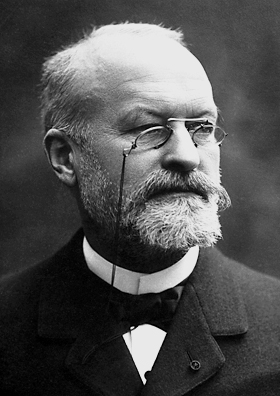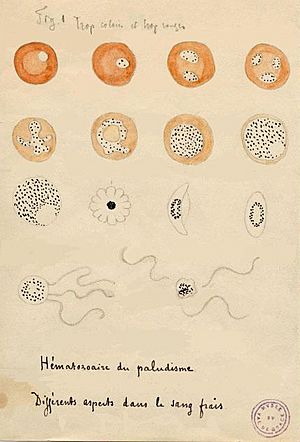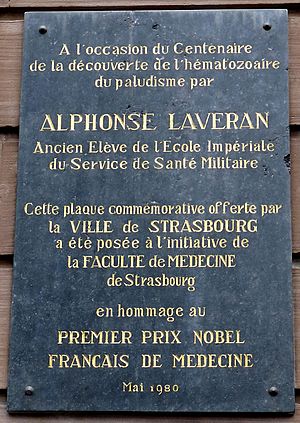Charles Louis Alphonse Laveran facts for kids
Quick facts for kids
Charles Louis Alphonse Laveran
|
|
|---|---|
 |
|
| Born | 18 June 1845 Paris, France
|
| Died | 18 May 1922 (aged 76) Paris, France
|
| Resting place | Cimetière du Montparnasse |
| Alma mater | University of Strasbourg |
| Known for | Trypanosomiasis, malaria |
| Spouse(s) | Sophie Marie Pidancet |
| Awards | Nobel Prize in Physiology or Medicine (1907) |
| Scientific career | |
| Fields | Tropical medicine Parasitology |
| Institutions | School of Military Medicine of Val-de-Grâce Pasteur Institute |
| Signature | |
 |
|
Charles Louis Alphonse Laveran (born June 18, 1845 – died May 18, 1922) was a French doctor. He won the Nobel Prize in Physiology or Medicine in 1907. He earned this award for finding out that tiny living things called protozoans cause serious illnesses. These diseases include malaria and trypanosomiasis, also known as African sleeping sickness.
Alphonse Laveran followed in his father's footsteps and became a military doctor. He earned his medical degree from the University of Strasbourg in 1867. He served in the French Army during the Franco-Prussian War in 1870. Later, he became a professor at the École de Val-de-Grâce. His most important discoveries happened when he worked in Algeria from 1878 to 1883. He found that the parasite Plasmodium causes malaria. He also learned that Trypanosoma causes African sleeping sickness. In 1896, he joined the Pasteur Institute to continue his research. He gave half of his Nobel Prize money to help create a special lab for tropical medicine there.
Contents
Early life and school
Alphonse Laveran was born in Paris, France. His father, Louis Théodore Laveran, was an army doctor and a professor. His mother's father was also an army commander. This meant Alphonse grew up in a military family.
When he was young, his family moved to Metz and then to Blida in Algeria. In 1856, he returned to Paris for his education. He studied at Collège Sainte-Barbe and Lycée Louis-le-Grand. He decided to become a military doctor, just like his father. He studied medicine at the University of Strasbourg and in Paris. In 1867, he finished his medical degree. His final paper was about how nerves can grow back.
His career
After finishing school, Laveran became a medical assistant in the army. He served as a doctor during the Franco-Prussian War. He was even a prisoner of war for a short time. After the war, he worked in a hospital in Lille.
In 1874, he became a professor at the École de Val-de-Grâce. This was the same job his father had held. From 1878 to 1883, he worked in military hospitals in Algeria. This is where he started to study blood infections, especially malaria. He also investigated a skin disease called Biskra button.
From 1884 to 1889, Laveran taught military hygiene. In 1894, he became a chief medical officer. He was promoted to a high rank in the army medical service. In 1896, he joined the Pasteur Institute. There, he could focus all his time on researching tropical diseases.
What he discovered

Malaria and finding its cause
Laveran first saw malaria parasites while working in Constantine, Algeria. At that time, people thought malaria was caused by bad air. Laveran looked at blood samples from people with malaria. He saw dark cells, which are now known to be red blood cells infected with the malaria parasite.
He was the first to think these infected blood cells were caused by parasites. On October 20, 1880, he saw the parasite clearly. He drew detailed pictures of it. He noticed not only the dark cells but also cells with moving parts. He kept studying more malaria cases. On December 24, he shared his findings with other doctors. He described three main shapes of the malaria parasite. These are now known as gametocytes, male gametes, and trophozoites.
Laveran's report was published in 1881. He also wrote a book about it. He named the parasite Oscillaria malariae. Today, it is officially called Plasmodium falciparum. This was the first time anyone showed that protozoans could cause a disease. This discovery helped prove the idea that tiny germs cause diseases.
However, many doctors didn't believe him at first. They thought bacteria caused malaria. But five years later, another scientist named Camillo Golgi confirmed Laveran's discovery. Golgi used better microscopes and ways to stain the blood.
Laveran also supported the idea that mosquitoes spread malaria. This idea was developed by Patrick Manson and proven by Ronald Ross. Laveran pushed for mosquito control to fight malaria in places like Corsica.
Leishmaniasis
Laveran also studied another disease caused by protozoans, called cutaneous leishmaniasis. This disease causes button-like skin sores. He studied it in Biskra, Algeria.
In 1903, while at the Pasteur Institute, he received samples from India. With his helper, Félix Mesnil, he identified the protozoan that causes a similar disease, visceral leishmaniasis. They named it Piroplasma donovanii, which was later changed to Leishmania donovani. He also reported the first case of this disease in children from Tunisia in 1904.
Trypanosomiasis
Laveran also worked on trypanosomes. He showed that these protozoans cause diseases like sleeping sickness in humans. They also cause illnesses in animals, such as nagana in cattle.
He identified several new types of trypanosomes. For example, he found Trypanosoma theileri in cattle in 1902. With Mesnil, he found trypanosomes in eels and fish. In 1904, he published a big book called Trypanosomes and Trypanosomiases. This book described more than thirty new species of these parasites.
Awards and special recognition
Laveran received many awards for his work. In 1889, he won the Bréant Prize from the French Academy of Sciences. In 1902, he received the Edward Jenner Medal.
In 1907, he won the Nobel Prize in Physiology or Medicine. The prize was given "in recognition of his work on the role played by protozoa in causing diseases." He used half of his prize money to help start the Laboratory of Tropical Medicine at the Pasteur Institute. He was also an honorary member of many important scientific groups, like the Royal Society.
In 1908, he started a group called the Société de pathologie exotique. He led this group for 12 years. He became a member of the French Academy of Sciences in 1893 and was its President in 1920. In 1912, he was given the high honor of Commander of the National Order of the Legion of Honour.
His life and death
Alphonse Laveran married Sophie Marie Pidancet in 1885. They did not have any children.
He passed away in Paris in 1922 after being sick for several months. He is buried in the Cimetière du Montparnasse in Paris.
How he is remembered
Laveran's name is on a special wall at the London School of Hygiene & Tropical Medicine. His name is one of twenty-three pioneers in public health and tropical medicine honored there.
Works
Laveran was a very focused researcher. He wrote more than 600 scientific papers. Some of his main books include:
- Nature parasitaire des accidents de l'impaludisme, description d'un nouveau parasite trouvé dans le sang des malades atteints de fièvre palustre. Paris 1881
- Traité des fièvres palustres avec la description des microbes du paludisme. Paris 1884
- Traité des maladies et épidémies des armées. Paris 1875
- Trypanosomes et Trypanosomiases . Masson, Paris 1904 Digital edition by the University and State Library Düsseldorf
Images for kids
See also
 In Spanish: Charles Louis Alphonse Laveran para niños
In Spanish: Charles Louis Alphonse Laveran para niños




